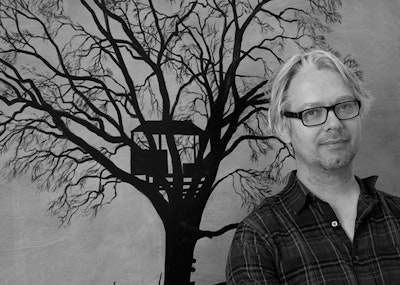
Peter Ern
Peter Ern is born in Sollentuna, Sweden 1965. Lives and works in Norrtälje.
Peter Ern’s art forces us to sharpen our gaze. Not because his images are complicated or unfathomable, but rather because they are always so focused and precise. Everything in Peter Ern’s paintings looks as though it is there out of pure necessity. Superfluous details distracting the gaze from the main motif have no place in his imagery. This notwithstanding, his paintings always include fragments of potential stories. No loud assertions and narratives, but subtler, lingering images of a fleeting moment. As when his eye catches something along the highway between Stockholm and his home in Norrtälje; a road sign, trees silhouetted against the sky, buildings, or a figure waiting at a bus stop. The paintings could almost be film stills. Although nature and trees often appear in Peter Ern’s paintings, it is actually an urbanised world we see depicted. In other words, this is not about portraying a pristine and romanticised nature, and despite the fact that people seldom appear in the paintings, one can always find traces of their existence. I see his artistic strategy as not about having others appreciate the beauty of trivial aspects of everyday life, but more about the desire to be able to see without getting caught up in details. It is, at the same time, clearly apparent how the paintings always usher my gaze towards various everyday scenes. Both a hazy day at the beach and a sprawling Monstera plant on a windowsill are captured with the same level of acuity, and although the motifs are commonplace, there is no sense of detachment or distanced approach to them. When Ern uses photographs (his own as well as those of others) as his point of departure, it is not in order to photographically depict reality. Instead, this is his way of analysing, for example, what a four-lane highway looks like as it veers off into the surrounding nature, how people move, or what a particular species of tree looks like. Those well acquainted with art history will also find several references to or borrowed elements from other artists.Peter Ern’s attempts at achieving a concentration in his pictures becomes all the more clear as one views the paintings from recent years with their recurring motifs such as the sign in the shape of a cloud on the roof of the baby supply store, Babyland, or the clothes on display in a shop window. In the painting “Britt’s Fashion” from 2006, the clothes appear clearly and in stark contrast to the otherwise dark shop window, with a lit window with drawn curtains on the second floor. In an earlier painting the proportions of the house are slightly different, but the basic features are the same. The four shop windows bathe in a strong white light, while all the windows in the second floor are dark. The mannequins in the shop windows are seen here only as dark silhouettes. In both paintings, the house is desolately situated on a street half-lit by street lamps. At the same time, one can wonder what it is that allows us to recognise the house as well as many of the other locations in his paintings? What is it that keeps his paintings from simply being private diary images that merely tell of places and moods the artist has experienced in his home environment outside Norrtälje and elsewhere? Chances are, the answer lies in Peter Ern’s ability to entice the viewer to sharpen his/her gaze by constantly reducing and clearing away all irrelevant elements from his pictures. Peter Ern thereby achieves a perspicuity without fixing the paintings to one interpretation. If one furthermore chooses to view the paintings as memory images, they remain as open in character as fleeting dreams and recollections.
